
The Rex is a cinema in the town of Berkhamsted, Hertfordshire, England. Designed in the art deco style by David Evelyn Nye in 1936, the cinema opened to the public in 1938. After 50 years of service, the cinema closed in 1988 and became derelict. The building was listed Grade II by English Heritage, and following a campaign to save the Rex by a local entrepreneur, the cinema re-opened to the public in 2004.
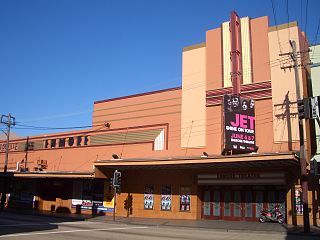
The Enmore Theatre is a theatre and entertainment venue in Enmore, New South Wales, Australia. It was built in 1908. It is located at 118–132 Enmore Road in Newtown, in the inner west of Sydney's suburbs. It was first opened in 1912 as a photo-play theatre. It was run by a well-known theatre family at the time, the Szarka Brothers. Today's Enmore Theatre is the longest running live theatre in Sydney, hosting concerts, comedians, plays and all forms of performance. The theatre is considered a medium-sized venue that holds 1,700 people when fully seated and 2,500 when seats are removed, and all attendees are standing. It has hosted many international bands including a performance by Bob Dylan. The venue's art deco style is protected by its listing as a historic building within Sydney. The Enmore theatre has had many renovations and shifts of ownership. Today it is owned by Century and has hosted a range of arts from photographic, performing arts, music and motion picture. The theatre's listing in the Office of Environment and Heritage states that the building "illustrates the development of suburban theatres in the late 1930s and early 1940s and is of social significance for the local community.″ It is the only theatre in Sydney from the Art Deco movement in its original condition. From cinema use to concerts, today is used for various reasons.


Somerset is a county in the south west of England. It has a varied cultural tradition ranging from the Arthurian legends to The Wurzels, a band specialising in Scrumpy and Western music.

The Hippodrome Cinema in Bo'ness near Falkirk is an early example of a purpose-built cinema and thought to be the oldest such building surviving in Scotland. The cinema, which opened in 1912, was built for the Bo'ness cinematography pioneer Louis Dickson and designed by renowned local architect Matthew Steele. It is designated as a Category A listed building.

The Coliseum of Porto is a Portuguese theatre and concert venue in the municipality of Porto, in northern Portugal, with a capacity for a standing audience of 4000. A leading venue for music and cultural events in Porto, together with Batalha Cinema, the Coliseu is an example of Portuguese Streamline Moderne and Art Deco styles in the city of Porto.

Bridlington Spa is a dance hall, theatre and conference centre in Bridlington, East Riding of Yorkshire, England. Refurbished between 2006 and 2008 and further updated with a new branding in 2016, the venue boasts a large Art Deco ball room, Edwardian theatre, art gallery and a selection of other meeting and event spaces; all featuring outstanding views over Bridlington's South Bay.
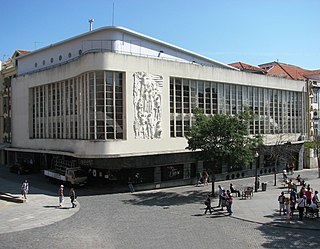
The Cinema Batalha is a Portuguese cinema and concert venue in civil parish of Cedofeita, Santo Ildefonso, Sé, Miragaia, São Nicolau e Vitória, municipality of Porto. Originally known as the Salão High-Life, it was moved from Boavista by its owners to its current location, and rebuilt by architect Artur Andrade in the Art-Deco style, re-inaugurated on 3 June 1947. After many years of success, the building and the cinema began losing customers, and was closed in 2003.

The Astor Theatre is located at 659 Beaufort Street, Mount Lawley, Western Australia. It comprises a single, two and three-storey masonry inter-war Art Deco style theatre and retail building.
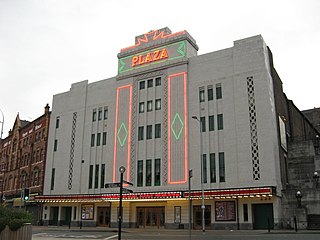
The Plaza is a Grade II* listed art deco single-screen cinema and theatre in Mersey Square, Stockport, England. It opened in 1932, its construction having involved the excavation of the sandstone cliff behind it. After an initial closure in 1966 and a subsequent period in use as a bingo hall by Rank Leiure, it has now been restored as a cinema and theatre, showing films and staging live shows.

The Marina is a theatre and cinema in Lowestoft, Suffolk, originally opened in the Victorian era. The venue has an auditorium seating 800. It plays host to major West End productions, top comedy, orchestral concerts, touring drama and musical productions, opera, ballet, music, dance and celebrity concerts as well as operating a successful cinema operation - boasting the largest screen and cinema auditoria in the town. The Marina annually hosts the largest professional pantomime on the East Anglian Coast.

Brighton Hippodrome is an entertainment venue in Brighton, England. It was built in 1897 and closed in 2007.
Aberdeen has been the host of several theatres and concert halls through history. Some of them have been converted or destroyed over the years.

John Stanley Coombe Beard FRIBA, known professionally as J. Stanley Beard, was an English architect known for designing many cinemas in and around London.
Bradford Odeon is the name applied to two different cinemas in central Bradford, West Yorkshire, England. One, in Godwin Street, was built in 1930 and survives; the other, in Manchester Road, was built in 1938 and demolished in 1969.
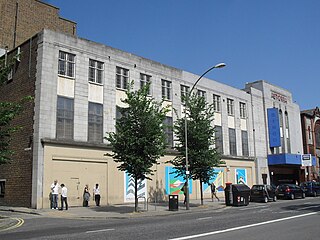
The Astoria Theatre was a former cinema in Brighton, part of the English coastal city of Brighton and Hove. Built in 1933 in the Art Deco style for a local entertainment magnate who opened one of Brighton's first cinemas many years earlier, it was the first and most important expansion of the Astoria brand outside London. It initially struggled against the town's other "super-cinemas", but enjoyed a period of success in the 1950s and 1960s before rapid decline set in, culminating in its closure in 1977.

Towers Cinema was a former cinema in Hornchurch, England. It was built in 1935 on part of the former Grey Towers estate and was noted for its Art Deco style of architecture. From 1973 it was used as a bingo hall until it closed in 2015. Despite the efforts of a local campaign to preserve the structure and to have it listed by Historic England, the building was demolished to make way for a Lidl supermarket.

The Embassy Cinema is a former cinema in the town of Chadwell Heath, Greater London. It was once known, among locals, as The Gaumont. It was designed in an art deco style, with a streamline moderne interior, by Harry Weston in 1934. The building is situated on the border of Redbridge and Barking & Dagenham, in the Chadwell Heath District Centre. The cinema closed in 1966 and became a Bingo Hall. In 2015, following the closure of the Bingo Hall, it was then used as a wedding hall/banqueting suite. The building was listed as an Asset of Community Value by the 'Chadwell Heath South Residents' Association' in August 2017 and is currently the focus of a major cinema restoration project.

Roxy Theatre and Peters Greek Cafe Complex is a heritage-listed theatre and cafe at 74 Maitland Street, Bingara, Gwydir Shire, New South Wales, Australia. It was designed by Mark Woodforde with construction supervised by George Psaltis of the Greek partnership Peters and Co. in 1935-1936. It was added to the New South Wales State Heritage Register on 25 August 2017.
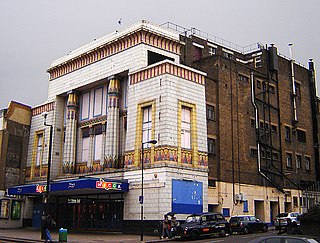
The former Carlton Cinema is an Art deco Grade II* listed building, located at 161–169 Essex Road, Islington, London. It was completed in 1930 as a cine-variety theatre with a capacity of 2,226 seats.



















